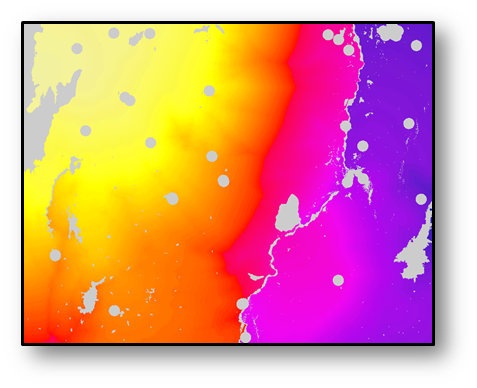- Home
- :
- All Communities
- :
- Products
- :
- Spatial Data Science
- :
- Spatial Data Science Questions
- :
- Re: Use of Hex based raster for Cost Distance
- Subscribe to RSS Feed
- Mark Topic as New
- Mark Topic as Read
- Float this Topic for Current User
- Bookmark
- Subscribe
- Mute
- Printer Friendly Page
- Mark as New
- Bookmark
- Subscribe
- Mute
- Subscribe to RSS Feed
- Permalink
Dear All,
I have recently been looking for any papers, tutorials, or presentations on using hex based movement instead of traditional square raster's. Any and all references appreciated.
In addition I have found several aftermarket solutions ( Tim Whiteaker's sampling hex ESRI blog) into creating hex raster's but would like to know if ESRI have yet developed a Hex raster creation tool? Or a raster square to raster hex tool?
All comments gratefully received.
Yours
Jeff Chartrand
Solved! Go to Solution.
Accepted Solutions
- Mark as New
- Bookmark
- Subscribe
- Mute
- Subscribe to RSS Feed
- Permalink
The problem with octagons is that the grid of octagons has gaps:
If you cost raster is has little variation than you will notice the effect of the square grid cells, if it has high variation you will not notice it.

The other aspect to consider is the accuracy of the result. is your input and methodology this precise to require the hexagonal grid cells? In other words, will the effort you will have to invest in using a different shape of cell really yield a better result?
- Mark as New
- Bookmark
- Subscribe
- Mute
- Subscribe to RSS Feed
- Permalink
The referenced blog post by the OP is: A new tool for creating sampling hexagons | ArcGIS Blog
The cost distance analysis is based on rasters. A raster inside ArcGIS is based on square cells (some tool might support rectangles but not hex). You could build something similar based on vector format (hex polygons), but this would require quite a lot of programming.
Why would you want to use hex shapes cells for the cost distance analysis? Can you elaborate on that?
- Mark as New
- Bookmark
- Subscribe
- Mute
- Subscribe to RSS Feed
- Permalink
Hi, sorry about the delay I was on leave.
Hex based movement over a terrain is more realistic than square based as it allows for increased directionality. I suspect that is why the gaming industry uses it. I was hoping that we might move beyond simple square cost distance movement. Ultimately I would like to see if we could integrate an octagon rather than hexagon as the eight sides would be a far better approximation of real movement in terrain cost distance.
Square (N, S, E, W) (four core movement directions)
Hex (NW, NE, E, W, SW, SE) (six core movement directions)
Octagon (N, S, E, W, NW, NE, SW, SE) (eight core movement directions)
Does that help explain my thinking? ![]()
Jeff
- Mark as New
- Bookmark
- Subscribe
- Mute
- Subscribe to RSS Feed
- Permalink
The problem with octagons is that the grid of octagons has gaps:
If you cost raster is has little variation than you will notice the effect of the square grid cells, if it has high variation you will not notice it.

The other aspect to consider is the accuracy of the result. is your input and methodology this precise to require the hexagonal grid cells? In other words, will the effort you will have to invest in using a different shape of cell really yield a better result?
- Mark as New
- Bookmark
- Subscribe
- Mute
- Subscribe to RSS Feed
- Permalink
There are numerous hex sample tools out there, Tim's mentioned above is probably the most mature and curated one. There is not an official Esri hex tool.
At the heart of this is a question of wanting a movement model that uses more than 4 directions, and just want to make sure everyone is aware that the Cost Distance tool is an 8 direction movement model. It uses the 4 faces of the raster, as well as the 4 diagonals, and appropriately weights the diagonals for their increased distance.
Steve
- Mark as New
- Bookmark
- Subscribe
- Mute
- Subscribe to RSS Feed
- Permalink
...as for an official "Hex tool" Creating thematic maps with hexagons in ArcGIS Online | ArcGIS Blog